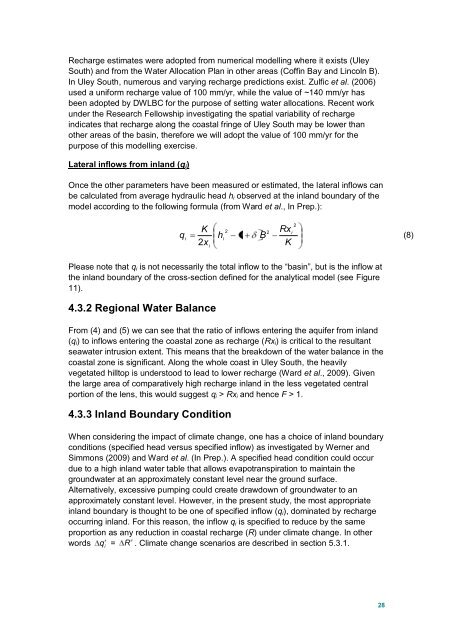Saltwater intrusion in Southern Eyre Peninsula, December 2009
Saltwater intrusion in Southern Eyre Peninsula, December 2009
Saltwater intrusion in Southern Eyre Peninsula, December 2009
You also want an ePaper? Increase the reach of your titles
YUMPU automatically turns print PDFs into web optimized ePapers that Google loves.
Recharge estimates were adopted from numerical modell<strong>in</strong>g where it exists (Uley<br />
South) and from the Water Allocation Plan <strong>in</strong> other areas (Coff<strong>in</strong> Bay and L<strong>in</strong>coln B).<br />
In Uley South, numerous and vary<strong>in</strong>g recharge predictions exist. Zulfic et al. (2006)<br />
used a uniform recharge value of 100 mm/yr, while the value of ~140 mm/yr has<br />
been adopted by DWLBC for the purpose of sett<strong>in</strong>g water allocations. Recent work<br />
under the Research Fellowship <strong>in</strong>vestigat<strong>in</strong>g the spatial variability of recharge<br />
<strong>in</strong>dicates that recharge along the coastal fr<strong>in</strong>ge of Uley South may be lower than<br />
other areas of the bas<strong>in</strong>, therefore we will adopt the value of 100 mm/yr for the<br />
purpose of this modell<strong>in</strong>g exercise.<br />
Lateral <strong>in</strong>flows from <strong>in</strong>land (q i )<br />
Once the other parameters have been measured or estimated, the lateral <strong>in</strong>flows can<br />
be calculated from average hydraulic head h i observed at the <strong>in</strong>land boundary of the<br />
model accord<strong>in</strong>g to the follow<strong>in</strong>g formula (from Ward et al., In Prep.):<br />
q<br />
i<br />
K<br />
2x<br />
i<br />
h<br />
i<br />
2<br />
1<br />
B<br />
2<br />
Rxi<br />
K<br />
2<br />
(8)<br />
Please note that q i is not necessarily the total <strong>in</strong>flow to the “bas<strong>in</strong>”, but is the <strong>in</strong>flow at<br />
the <strong>in</strong>land boundary of the cross-section def<strong>in</strong>ed for the analytical model (see Figure<br />
11).<br />
4.3.2 Regional Water Balance<br />
From (4) and (5) we can see that the ratio of <strong>in</strong>flows enter<strong>in</strong>g the aquifer from <strong>in</strong>land<br />
(q i ) to <strong>in</strong>flows enter<strong>in</strong>g the coastal zone as recharge (Rx i ) is critical to the resultant<br />
seawater <strong><strong>in</strong>trusion</strong> extent. This means that the breakdown of the water balance <strong>in</strong> the<br />
coastal zone is significant. Along the whole coast <strong>in</strong> Uley South, the heavily<br />
vegetated hilltop is understood to lead to lower recharge (Ward et al., <strong>2009</strong>). Given<br />
the large area of comparatively high recharge <strong>in</strong>land <strong>in</strong> the less vegetated central<br />
portion of the lens, this would suggest q i > Rx i and hence F > 1.<br />
4.3.3 Inland Boundary Condition<br />
When consider<strong>in</strong>g the impact of climate change, one has a choice of <strong>in</strong>land boundary<br />
conditions (specified head versus specified <strong>in</strong>flow) as <strong>in</strong>vestigated by Werner and<br />
Simmons (<strong>2009</strong>) and Ward et al. (In Prep.). A specified head condition could occur<br />
due to a high <strong>in</strong>land water table that allows evapotranspiration to ma<strong>in</strong>ta<strong>in</strong> the<br />
groundwater at an approximately constant level near the ground surface.<br />
Alternatively, excessive pump<strong>in</strong>g could create drawdown of groundwater to an<br />
approximately constant level. However, <strong>in</strong> the present study, the most appropriate<br />
<strong>in</strong>land boundary is thought to be one of specified <strong>in</strong>flow (q i ), dom<strong>in</strong>ated by recharge<br />
occurr<strong>in</strong>g <strong>in</strong>land. For this reason, the <strong>in</strong>flow q i is specified to reduce by the same<br />
proportion as any reduction <strong>in</strong> coastal recharge (R) under climate change. In other<br />
words q = R . Climate change scenarios are described <strong>in</strong> section 5.3.1.<br />
i<br />
28

















